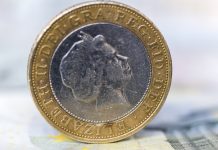The pound moved higher versus the dollar on Friday closing up 0.2% at US$1.2636. Yet despite the higher close, the pound still finished 0.6% lower versus the dollar for the week. That was the fourth straight week that the pound has lost ground versus the dollar. The pound was edging higher versus the dollar in early trade on Monday.
| What do these figures mean? |
|---|
| When measuring the value of a pair of currencies, one set equals 1 unit and the other shows the current equivalent. As the market moves, the amount will vary from minute to minute.For example, it could be written:1 GBP = 1.28934 USDHere, £1 is equivalent to approximately $1.29. This specifically measures the pound’s worth against the dollar. If the US dollar amount increases in this pairing, it’s positive for the pound. Or, if you were looking at it the other way around:1 USD = 0.77786 GBPIn this example, $1 is equivalent to approximately £0.78. This measures the US dollar’s worth versus the British pound. If the sterling number gets larger, it’s good news for the dollar. |
Demand for the pound declined in May as the political picture grew increasingly unstable and as concerns over a no deal Brexit increased. UK Prime Minister Theresa May resigned, the Brexit Party was the best performing UK party in the European Parliamentary elections and the possibility of a pro-Brexit candidate taking over from Theresa May increased. Should a pro-Brexit candidate win the Tory leadership battle, the possibility of a no deal Brexit would increase significantly. Economists have frequently warned that a no deal Brexit would be the most damaging type of Brexit for the UK economy and therefore the pound.
| Why is a “soft” Brexit better for sterling than a “hard” Brexit? |
|---|
| A soft Brexit implies anything less than UK’s complete withdrawal from the EU. For example, it could mean the UK retains some form of membership to the European Union single market in exchange for some free movement of people, i.e. immigration. This is considered more positive than a “hard” Brexit, which is a full severance from the EU. The reason “soft” is considered more pound-friendly is because the economic impact would be lower. If there is less negative impact on the economy, foreign investors will continue to invest in the UK. As investment requires local currency, this increased demand for the pound then boosts its value. |
Today investors will continue to watch developments in Westminster. There are now 13 candidates putting themselves forward for the position of Conservative leader and British prime minister. With so many candidates, the leadership race could bring further chaos to the Conservative party.
Investors will be watching UK manufacturing pmi data. Analysts are expecting data to show that the UK manufacturing sector slowed again in May. The slight slowing of momentum in the economy shows that Brexit continues to hamper the UK economy.
Concerns Over US Economy Weigh On Dollar
The dollar benefitted from escalating US — Sino trade tensions across the previous week. Rhetoric between the two powers indicated that the trade dispute could drag on for much longer than initially thought. This resulted in investors looking towards the dollar for its safe haven properties.
However, fears are growing that the trade dispute is starting to impact on the US economy. Data showed that US consumer sentiment increased by less than originally reported in May, as consumer concerns over US tariffs started to hit. On the one hand the strong labour force is lifting consumer sentiment, but more recently the US — Sino trade war is unnerving investors. If consumers start to get nervous, they tend to spend less which is not good news for the economy. As a result, the dollar declined.
Today investors will pay close attention to US manufacturing data. Another weak reading could pull the dollar lower. Investors are nervous that the Federal Reserve will be forced to cut interest rates by the end of the year, amid a prolonged messy trade dispute impacting on US economic growth.
| Why do raised interest rates boost a currency’s value? |
|---|
| Interest rates are key to understanding exchange rate movements. Those who have large sums of money to invest want the highest return on their investments. Higher interest rate environments tend to offer higher yields. So, if the interest rate or at least the interest rate expectation of a country is relatively higher compared to another, then it attracts more foreign capital investment. Large corporations and investors need local currency to invest. More local currency used then boosts the demand of that currency, pushing the value higher. |
This publication is provided for general information purposes only and is not intended to cover every aspect of the topics with which it deals. It is not intended to amount to advice on which you should rely. You must obtain professional or specialist advice before taking, or refraining from, any action on the basis of the content in this publication. The information in this publication does not constitute legal, tax or other professional advice from TransferWise Inc., Currency Live or its affiliates. Prior results do not guarantee a similar outcome. We make no representations, warranties or guarantees, whether express or implied, that the content in the publication is accurate, complete or up to date. Consult our risk warning page for more details.
This article was initially published on TransferWise.com from the same author. The content at Currency Live is the sole opinion of the authors and in no way reflects the views of TransferWise Inc.





